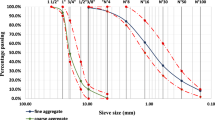Abstract
Sustainable construction becomes a highly key topic in the construction sector owing to its benefits and advantages over economy, environment, and society. This study considers one such application of sustainable construction, rehabilitation of RC beams. Through such rehabilitation, it is possible to extend the life of existing concrete structures. A numerical analysis approach has been framed to study to this phenomenon. Total 10 criteria have been selected to evaluate the rehabilitation material alternatives on RC beams with ultra-high-performance concrete. 9 Alternative materials have been considered for rehabilitation of RC beams. DEMATEL-ANP and PROMETHEE has been used as a methodology in two phases, the first phase used DEMATEL-ANP to analyze the considered criteria and the second phase used PROMETHEE to evaluate the considered alternative materials based on the analyzed criteria. Finally, this study concludes with the effective rehabilitation material for RC beams with ultra-high-performance-concrete. The considered numerical framework can be adopted in various forms of similar or different applications.

Similar content being viewed by others
References
Abdel-Basset, M., Gamal, A., Chakrabortty, R. K., & Ryan, M. (2021). A new hybrid multi-criteria decision-making approach for location selection of sustainable offshore wind energy stations: A case study. Journal of Cleaner Production, 280, 124462.
Aditi, G. K., & Jha, P. C. (2024). Modelling of barriers in implementing sustainable manufacturer-supplier collaboration and coping strategies. Journal of Cleaner Production, 434, 139635.
Ahmed, S., & El-Sayegh, S. (2022). The challenges of sustainable construction projects delivery–evidence from the UAE. Architectural Engineering and Design Management, 18(3), 299–312.
Amiri, A., Emami, N., Ottelin, J., Sorvari, J., Marteinsson, B., Heinonen, J., & Junnila, S. (2021). Embodied emissions of buildings-A forgotten factor in green building certificates. Energy and Buildings, 241, 110962.
Amiri, A., Ottelin, J., & Sorvari, J. (2019). Are LEED-certified buildings energy-efficient in practice? Sustainability, 11(6), 1672.
Baloch, W. L., Siad, H., Lachemi, M., & Sahmaran, M. (2021). A review on the durability of concrete-to-concrete bond in recent rehabilitated structures. Journal of Building Engineering, 44, 103315.
Belussi, L., Barozzi, B., Bellazzi, A., Danza, L., Devitofrancesco, A., Fanciulli, C., Ghellere, M., Guazzi, G., Meroni, I., Salamone, F., & Scamoni, F. (2019). A review of performance of zero energy buildings and energy efficiency solutions. Journal of Building Engineering, 25, 100772.
Carbonell Muñoz, M. A., Harris, D. K., Ahlborn, T. M., & Froster, D. C. (2014). Bond performance between ultrahigh-performance concrete and normal-strength concrete. Journal of Materials in Civil Engineering, 26(8), 04014031.
Chauhan, A., Kaur, H., Yadav, S., & Jakhar, S. K. (2020). A hybrid model for investigating and selecting a sustainable supply chain for agri-produce in India. Annals of Operations Research, 290, 621–642.
Chen, Z. S., Martinez, L., Chang, J. P., Wang, X. J., Xionge, S. H., & Chin, K. S. (2019). Sustainable building material selection: A QFD-and ELECTRE III-embedded hybrid MCGDM approach with consensus building. Engineering Applications of Artificial Intelligence, 85, 783–807.
Fitriani, H., & Ajayi, S. (2022). Barriers to sustainable practices in the Indonesian construction industry. Journal of Environmental Planning and Management, 66, 1–23.
Flores, R. A., & Ghisi, E. (2022). Water benchmarking in buildings: A systematic review on methods and benchmarks for water conservation. Water, 14(3), 473.
Gaganis, C., Papadimitri, P., & Tasiou, M. (2021). A multicriteria decision support tool for modelling bank credit ratings. Annals of Operations Research, 306, 27–56.
Geng, Y., Ji, W., Wang, Z., Lin, B., & Zhu, Y. (2019). A review of operating performance in green buildings: Energy use, indoor environmental quality and occupant satisfaction. Energy and Buildings, 183, 500–514.
Goh, C. S., Chong, H. Y., Jack, L., & Faris, A. F. M. (2020). Revisiting triple bottom line within the context of sustainable construction: A systematic review. Journal of Cleaner Production, 252, 119884.
Grazide, C., Ferrier, E., & Michel, L. (2020). Rehabilitation of reinforced concrete structures using FRP and wood. Construction and Building Materials, 234, 117716.
James, A., Bazarchi, E., Chiniforush, A. A., Aghdam, P. P., Hosseini, M. R., Akbarnezhad, A., Martek, I., & Ghodoosi, F. (2019). Rebar corrosion detection, protection, and rehabilitation of reinforced concrete structures in coastal environments: A review. Construction and Building Materials, 224, 1026–1039.
Jędrzejczak, P., Collins, M. N., Jesionowski, T., & Klapiszewski, Ł. (2021). The role of lignin and lignin-based materials in sustainable construction–a comprehensive review. International Journal of Biological Macromolecules, 187, 624–650.
Kibert, C. J. (2016). Sustainable construction: Green building design and delivery. John Wiley & Sons.
Li, Y., Diabat, A., & Lu, C. C. (2020). Leagile supplier selection in Chinese textile industries: A DEMATEL approach. Annals of Operations Research, 287, 303–322.
Maqbool, R., & Amaechi, I. E. (2022). A systematic managerial perspective on the environmentally sustainable construction practices of UK. Environmental Science and Pollution Research, 29(42), 64132–64149.
Maqbool, R., Saiba, M. R., Altuwaim, A., Rashid, Y., & Ashfaq, S. (2022). The influence of industrial attitudes and behaviours in adopting sustainable construction practices. Sustainable Development, 31(2), 893–907.
Megahed, N. A., & Ghoneim, E. M. (2021). Indoor Air Quality: Rethinking rules of building design strategies in post-pandemic architecture. Environmental Research, 193, 110471.
Mi, R., Chen, C., Keplinger, T., Pei, Y., He, S., Liu, D., Li, J., Dai, J., Hitz, E., Yang, B., & Burgert, I. (2020). Scalable aesthetic transparent wood for energy efficient buildings. Nature Communications, 11(1), 3836.
Mohamed, A. S., Xiao, F., & Hettiarachchi, C. (2022). Project level management decisions in construction and rehabilitation of flexible pavements. Automation in Construction, 133, 104035.
Ogunmakinde, O. E., Egbelakin, T., & Sher, W. (2022). Contributions of the circular economy to the UN sustainable development goals through sustainable construction. Resources, Conservation and Recycling, 178, 106023.
Pelissari, R., Oliveira, M. C., Amor, S. B., Kandakoglu, A., & Helleno, A. L. (2020). SMAA methods and their applications: A literature review and future research directions. Annals of Operations Research, 293, 433–493.
Pham, H., Kim, S. Y., & Luu, T. V. (2020). Managerial perceptions on barriers to sustainable construction in developing countries: Vietnam case. Environment, Development and Sustainability, 22, 2979–3003.
Qualharini, E. L., Oscar, L. H. C., & Silva, M. R. D. (2019). Rehabilitation of buildings as an alternative to sustainability in Brazilian constructions. Open Engineering, 9(1), 139–143.
Rodríguez, V., Guerrero, H., Alcocer, S. M., & Tapia-Hernández, E. (2021). Rehabilitation of heavily damaged beam-column connections with CFRP wrapping and SFRM casing. Soil Dynamics and Earthquake Engineering, 145, 106721.
Roseline, S., Paramasivam, V., Anandhakrishnan, R., & Lakshminarayanan, P. R. (2019). Numerical evaluation of zirconium reinforced aluminium matrix composites for sustainable environment. Annals of Operations Research, 275, 653–667.
Roy, J., Das, S., Kar, S., & Pamučar, D. (2019). An extension of the CODAS approach using interval-valued intuitionistic fuzzy set for sustainable material selection in construction projects with incomplete weight information. Symmetry, 11(3), 393.
Salih, M. M., Osofero, A. I., & Imbabi, M. S. (2020). Critical review of recent development in fiber reinforced adobe bricks for sustainable construction. Frontiers of Structural and Civil Engineering, 14, 839–854.
Santos, J., Torres-Machi, C., Morillas, S., & Cerezo, V. (2022). A fuzzy logic expert system for selecting optimal and sustainable life cycle maintenance and rehabilitation strategies for road pavements. International Journal of Pavement Engineering, 23(2), 425–437.
Tavana, M., Khalili-Damghani, K., & Rahmatian, R. (2015). A hybrid fuzzy MCDM method for measuring the performance of publicly held pharmaceutical companies. Annals of Operations Research, 226, 589–621.
Tokbolat, S., Karaca, F., Durdyev, S., & Calay, R. K. (2020). Construction professionals’ perspectives on drivers and barriers of sustainable construction. Environment, Development and Sustainability, 22, 4361–4378.
Tsarpalis, P., Vayas, I., Thanopoulos, P. and Vamvatsikos, D., (2021) Rehabilitation of reinforced concrete building using the fuseis beam-link system. In Structures. Elsevier. Vol. 34, pp. 3300–3314.
Udomsap, A. D., & Hallinger, P. (2020). A bibliometric review of research on sustainable construction, 1994–2018. Journal of Cleaner Production, 254, 120073.
Veselka, J., Nehasilová, M., Dvořáková, K., Ryklová, P., Volf, M., Růžička, J., & Lupíšek, A. (2020). Recommendations for developing a BIM for the purpose of LCA in green building certifications. Sustainability, 12(15), 6151.
Xidonas, P., Lekkos, I., Giannakidis, C., & Staikouras, C. (2023). Multicriteria security evaluation: does it cost to be traditional? Annals of Operations Research, 323, 1–30.
Xue, K., Hossain, M. U., Liu, M., Ma, M., Zhang, Y., Hu, M., Chen, X., & Cao, G. (2021). BIM integrated LCA for promoting circular economy towards sustainable construction: An analytical review. Sustainability, 13(3), 1310.
Yang, X., Zhang, B., Zhou, A., Wei, H., & Liu, T. (2023). Axial compressive behaviour of corroded steel reinforced concrete columns retrofitted with a basalt fibre reinforced polymer-ultrahigh performance concrete jacket. Composite Structures, 304, 116447.
Zhang, L., Balangé, L., Braun, K., Di Bari, R., Horn, R., Hos, D., Kropp, C., Leistner, P. & Schwieger, V. (2020). Quality as driver for sustainable construction—holistic quality model and assessment. Sustainability, 12(19), 7847.
Zhu, H., Wang, T., Wang, Y., & Li, V. C. (2021). Trenchless rehabilitation for concrete pipelines of water infrastructure: A review from the structural perspective. Cement and Concrete Composites, 123, 104193.
Author information
Authors and Affiliations
Corresponding author
Additional information
Publisher's Note
Springer Nature remains neutral with regard to jurisdictional claims in published maps and institutional affiliations.
Rights and permissions
Springer Nature or its licensor (e.g. a society or other partner) holds exclusive rights to this article under a publishing agreement with the author(s) or other rightsholder(s); author self-archiving of the accepted manuscript version of this article is solely governed by the terms of such publishing agreement and applicable law.
About this article
Cite this article
Karthik, K.M., Anuradha, R. Numerical analysis on rehabilitation material selection on RC beams with ultra-high-performance concrete: an application of sustainable construction. Ann Oper Res 335, 517–534 (2024). https://doi.org/10.1007/s10479-023-05803-7
Received:
Accepted:
Published:
Issue Date:
DOI: https://doi.org/10.1007/s10479-023-05803-7




